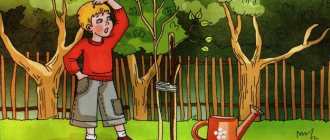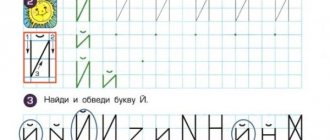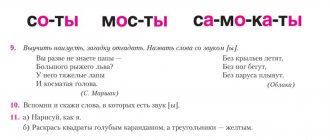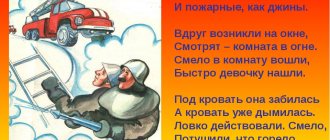Summary of the literacy lesson “Speech. Sentence. Word.”
Lesson No. 1
Objectives: To introduce children to the concepts of “speech” and “sentence”.
Tasks.
Correctional educational tasks:
- Form the concept of “speech”, “sentence”.
- Give the concept of a word as part of a sentence.
- Form a language analysis - determine the number of words in a sentence, the order of words in a sentence, find the place of a word in a sentence.
- Develop the ability to draw up a graphical outline of a sentence.
- Develop the ability to compose a sentence according to a diagram.
- Introduce children to the rules of writing a sentence.
- Update the dictionary on the topic.
- Develop coherent speech skills.
- To develop the skill of educational expression.
- Form the prerequisites for literacy.
Developmental tasks:
- Develop non-speech mental functions: attention, memory, thinking, emotional and volitional sphere.
- Develop the ability to justify your judgments.
Educational tasks:
- Improve communicative readiness for learning: the ability to listen carefully and hear the teacher - speech therapist, subordinate your actions to his instructions.
- Develop initiative and independence.
- Develop the ability to interact with peers and adults;
- Build self-control and self-esteem.
- Formation of prerequisites for educational activities in preschool children.
Vocabulary: speech, sentence, sentence diagram, capital letter, period, long, short.
Equipment and materials: multimedia equipment, sticks, pointer.
Progress of the lesson:
1. Organizational moment.
Speech therapist. In our classes we will learn to read. What do you think you need to be able to do and know in order to learn to read? Right.
2. Main part of the lesson:
2.1. Introduction to the concept of “speech”.
Speech therapist. Let's talk about our speech first. Speech is how we talk, tell stories, and ask questions. Now we will compose a story based on the picture. Look at the screen. (Working with electronic application 1, task in the “speech” section No. 1). Listen to the beginning of the story and come up with a continuation, talking about every detail of the picture ( children make up a collective story
).
2.2. Introduction to the concept of “offer”.
Speech therapist. When we composed the story, we said a sentence each time ( examples from the story are given
).
Sentences can be long or short. Why do you think one sentence is long and the other short ( the speech therapist leads children to the conclusion that the length of a sentence depends on the number of words
).
Who can say what a sentence consists of? Today we will learn to count words in sentences. Listen to the sentence and count the words in it. (The speech therapist offers the children 3 sentences: Autumn has come. It rains often. People are harvesting.
Children count words in sentences).
2.3. Familiarity with the rules of writing a proposal and drawing up a proposal outline.
Speech therapist. Can you and I write a proposal? Why? Today I will teach you how to “write” a sentence without letters. Take the sticks and lay out as many sticks as there were words in the last sentence. ( Children lay out a diagram.
) What is the first word in your sentence?
Second? Third? ( At the same time, the speech therapist draws a sentence diagram on the board
.) We have laid out a sentence diagram for you. Look what the first word looks like. The first word in a sentence is always written with a capital letter, so the first word is drawn with a “stump”. To show that a sentence has ended, a period is placed at the end of the sentence.
2.4. Dynamic pause.
2.5. Formation of practical skills in composing a proposal for a graphic proposal diagram.
Speech therapist. Look at the picture and the diagram under the picture. How many words are there in a sentence outline? Come up with sentences based on the picture that fit this scheme. ( Children name sentences, the speech therapist analyzes the sentences, correlating them with the diagram
.) (Work with electronic application 1, task in the “proposal” section No. 2).
2.6. Gymnastics for the eyes.
2.7. Formation of the ability to analyze a proposal.
Speech therapist. Listen to my sentence and count the number of words in it. (Working with electronic application 1, task in the “proposal” section No. 3).
3. Summary of the lesson.
Analysis and assessment of the level of mastery of material and children’s activities in class.
Speech therapist. What does our speech consist of? What does the proposal consist of? What letter is the first word in the sentence written with? What comes at the end of a sentence? If you think you did a good job, clap your hands.
Features of modeling during literacy training
The most important task of the modern education system is the formation of universal educational activities that provide schoolchildren with the ability to learn, the ability for self-development and self-improvement. Modeling contributes to the formation of cognitive learning activities, as well as better assimilation and understanding of the information received.
During the period of learning to read and write, which is the most important stage in the development of a child’s personality, the foundations of knowledge about the native language are laid, the main speech skills (reading and writing) are formed, and a certain attitude towards the Russian language, native speech and literature is formed.
Teaching literacy is carried out using the sound analytical-synthetic method, consists of two interrelated processes: teaching initial reading and teaching writing - and is reinforced by work on the development of speech at its main levels: sound (sound culture), word (vocabulary work), sentence, coherent utterance ( text).
There are three periods in literacy learning:
- preparatory (pre-letter);
- alphabetic (basic);
- post-literal.
Pre-literate period of learning to read and write
The tasks of the pre-letter period are the development of phonemic hearing, the ability to isolate sounds from a word, perform syllabic-sound and sound analysis of words; compare sounds in similar sounding words. At this stage of learning, the development of oral speech, listening and speaking skills plays an important role. During the lessons, the concepts of word, sentence, vowel sounds, syllables, and stress are introduced.
During this period, familiarity with modeling begins, when children are given their first ideas about speech (oral and written). Students become familiar with dividing speech into sentences, sentences into words, words into syllables using graphic diagrams. During this period, students learn to model a communication situation (who communicates with whom, what words they use), and use certain marks, drawings and signs.
From the first pages of the ABC, children become familiar with the features of oral speech, learn to isolate individual words from sentences, correctly coordinate words in a sentence, create their own statements based on illustrations, use drawings and signs - symbols, a way to designate objects and write a message, model sentences, designate individual words in a sentence.
Under the guidance of the teacher, children examine the illustrations, find out the basis of the plot, find each character and name him, and then make sentences and correlate them with the proposed diagrams.
The visual-figurative models of communication presented in “ABC” give children elementary ideas about the communication situation, partners (interlocutors) of verbal communication, and goals. For example, a task of this type: “Think about who could say the word “hello” and to whom?” allows you to develop the ability to construct a speech utterance in accordance with the communicative task.
Sentence modeling is work on constructing sentences, developing coherent speech, and is also one of the ways to awaken students’ cognitive activity in literacy lessons.
During the period of literacy learning, sentences consisting of 2-4 words are used for analysis. Children learn to analyze the composition of speech, which is of great importance for all further work. In lessons, we not only count the words in a sentence, but also talk about the meaning and content of each of them, moving from the analysis of individual words to the analysis of entire sentences and the entire story.
Schemes are used to include each student in active activities, bringing the material on the studied topic to full understanding. Students begin to model a sentence before they can write. It is good for each student to have an individual set of strips of colored paper for making sentence models.
This is how the psychological merging of the spoken word and the written word, but written without letters, gradually occurs. The child learns to count words in a sentence not only by ear, but also according to a diagram, where each line represents a word. The intervals between the lines indicate small stops - pauses.
In the future, you can use tasks to develop the analysis of sentence structure:
- come up with a sentence with a certain number of words according to given patterns;
- come up with a sentence for a given scheme with a certain word;
- determine the place of a word in a sentence (what kind of word is indicated);
- raise the number corresponding to the number of words in the sentence (2, 3, 4, 5);
- increase the number of words in a sentence;
- determine the boundaries of sentences in the text;
- come up with a sentence based on the plot picture and determine the number of words in it;
- make a sentence from words given in disorder (for example, garden bed, on, cucumbers, grow).
In the process of learning to read and write, students become familiar with the visual-figurative model of a word, the meaning of words (as an image of an object, action and property) and the sound of words (a sequence of speech sounds). Children select words that name the object in the picture, call the same object with different words - cat, cat (for example, Primer by L. E. Zhurova and A. O. Evdokimova).
During the learning process, children learn, in response to the teacher’s word, to select words with the opposite or similar meaning, and to supplement the sentence with words.
Initial learning to read involves developing the ability to read in syllables (and not letters), that is, mastering smooth syllabic, positional reading of words that children can understand. In this regard, familiarization with the syllabic structure of words occupies an important place in preparing children for learning to read and write.
It is very important to teach a child to read syllable by syllable, emphasizing the stressed syllable. The successful formation of this method of reading is facilitated by preparatory work, which begins even before children begin to read, that is, to translate the graphic (letter) form of a word into an audio one.
One of the areas of this preparatory work is dividing words into syllables, pronouncing words by syllables, and composing them from separately named syllables. In order for a student to correctly convey the sound side of a word in writing, without skipping or rearranging letters in it, he must be taught to divide the word into syllables, establish the place and sequence of sounds in it. To master the concept of “syllable” you can use such models.
During literacy learning in 1st grade, students gradually become familiar with letters. They learn that a syllable is part of a word that necessarily contains a vowel.
In order for children to learn to divide a word into syllables and determine the number of syllables in a word, they need to perform the following procedure:
- Place dots under all vowels with a red pencil.
- Count the points. How many dots - so many syllables. “The number of vowels in a word equals the number of syllables, each student knows this” is a rhyme that helps children remember the rule.
- Divide words into syllables. The main rule is that each syllable must have one vowel letter.
- “Call” the word as if it were lost in the forest: “li-si-tsa, doll-la, de-voch-ka”
- Divide the word into syllables with a vertical line. “li/si/tsa, kuk/la, de/voch/ka”
- Check again: “Each syllable must have one vowel, there must be as many syllables as there are vowels in the word.”
There are several techniques to help divide words into syllables:
- clap, tap or walk a word syllable by syllable;
- accompany the syllable pronunciation of the word by moving the hand from right to left and from left to right;
In different primers there are different options for dividing words into syllables. Thus, in the ABC of the “School of Russia” set by the authors V. G. Goretsky, V. A. Kiryushkin, L. A. Vinogradskaya and M. V. Boykina, the following option is proposed for dividing a word into syllables: a solid vertical line separates the merging syllables SG from each other , consonants outside SG syllables are separated by a dotted line.
In the Bukvara by L. E. Zhurova and A. O. Evdokimova, a different model of dividing words into syllables is used - syllables are indicated by an arc under the word diagram.
In the ABC, which is included in the educational and methodological set “Perspective” (authors L. F. Klimanova and S. G. Makeeva), the following type of models of the sound composition of the word and division into syllables is used:
At this stage, the teacher needs to introduce children to stress and teach them to highlight the stressed sound in any word. It is with stress that word recognition begins. Stress is one of the main characteristics of a word as a lexical unit. It combines sounds into a single phonetic word, the integrity of which depends both on the unifying force of the stressed word and on the properties of the unstressed parts. The general rhythmic structure of a word, which is determined by the number of syllables and the place of stress in the word, as well as the sound of the stressed syllable, play an important role in the processes of speech perception: they are one of the first signs with which word identification begins.
Stress in the Russian language is distinguished using three phonetic means: the duration of the stressed word (mainly the vowel sound included in the stressed syllable), the strength of the voice (the stressed syllable is pronounced louder than the unstressed one) and the quality of the stressed vowel (in the stressed syllable the vowel is pronounced with its main timbre, because it is pronounced in isolation).
The ability to highlight stress in a word is also important for subsequent language acquisition at school (for example, spelling unstressed vowels).
After children have learned to distinguish a particular sound in a word intonationally, they need to learn to determine the number of sounds in a word and their sequence.
For example, the game “Guess”:
Children learn to determine the number of sounds in a word and come up with words with a given number of sounds.
The student is given a card with a number written on it. The student, without showing it to his friends, comes up with a word with the number of sounds corresponding to the indicated number. The rest must guess what number is written on the card. Or the student pronounces a word and asks his friends to determine the number of sounds.
Thus, in the preliterate period, familiarity with language as a sign system is preceded by familiarity with the simplest sign systems (road signs, symbol signs, etc.), which helps children better understand the substitutive function of a word (a word names an object, but is not such). During this period, the method of writing words using pictograms and diagrams is actively used, which makes it much easier for children to divide speech into semantic parts of words and sentences. A modeling method is formed - building a model of sentences and words, models of syllable structure and sound models of words.
Alphabetical period of learning to read and write
During the main (literary) stage of literacy training, students work with material from the second section of the “ABC”. The development of children's phonemic hearing continues, the sound analysis of words and the ability to denote sounds with letters are formed. Students master basic reading and writing, consolidate knowledge about words and sentences, their structure.
When teaching initial reading, a variety of analytical and synthetic exercises are used, presented in a playful, visual form.
The training includes drawing (pictographic writing) and entertaining puzzles - a unique way of graphically recording a word.
Working with word models, children draw conclusions about how the word is structured and compare words by sound and meaning.
To teach children to do sound-letter analysis of words, it is necessary to form in students a clear idea of vowels, consonants, hard and soft sounds.
Vowel sounds get their name from the word “voice”. This is how the word “voice” used to be pronounced. When we pronounce vowel sounds, air flows freely through the mouth. Nothing “interferes” with these sounds - neither teeth, nor lips, nor tongue, and we only hear the voice. To make sure that their conclusions are correct, children “test” all the sounds as they pronounce them and observe whether anything in their mouth interferes with their pronunciation.
There are 6 vowel sounds in the Russian language [a], [o], [u], [s], [i], [e]. In L. E. Zhurova’s Primer and V. G. Goretsky’s ABC, vowel sounds are denoted by a red square.
After consonants, the letters e, e, yu, i indicate the sounds [e], [o], [u], [a].
At the same time, children become familiar with vowel letters, there are 10 of them: a, o, u, s, i, e, e, e, yu, i.
At the initial stage, it is proposed to isolate a vowel sound from a syllable, for example: ah, us, ma, yes, kra, ast, angry. Tasks can be completed using a cut alphabet or a fan.
- Raise the letter corresponding to the vowel sound of the syllable.
- Come up with a syllable with the corresponding vowel
- Determine the place of the vowel sound in the syllable and show the corresponding letter.
- Come up with a syllable in which the vowel sound is in first, second or third place.
In the ABC of L.F. Klimanova and S.G. Makeeva, the following symbol is used to indicate a vowel sound: an empty red bead shows that when pronouncing a vowel sound, air flows freely through the mouth without encountering obstacles.
By becoming familiar with consonant letters, children learn which letters represent them. When pronouncing consonant sounds, a stream of air encounters obstacles in its path: the tongue, lips, teeth, take the position necessary for a certain sound. The “Consonant Sounds” table will help you work with sound models of words.
According to voicedness - deafness: all consonants are divided into two groups:
Voiced - [b] [c] [d] [d] [z] [y] [l] [m] [n] [r]
deaf - [p] [f] [k] [t] [s] [x] [ts] [h] [sch]
What is the difference between a voiceless and a voiced sound?
When a voiced sound is pronounced, the voice participates in its formation, and we hear the noise. When pronouncing a dull sound, the voice does not participate in its formation; we hear noise. You can use the “put your hand to the throat” technique: when pronouncing voiced sounds, vibration occurs (“the throat trembles”), but when making dull sounds, this does not happen.
Most consonants can indicate two sounds: hard and soft.
By hardness - softness:
Soft - [b ̕] [v ̕] [g ̕] [d ̕] [z ̕] [k ̕] [l ̕] [m ̕] [n ̕] [p ̕] [p ̕] [s ̕] [t ̕] [f ̕] [x ̕]
Solid - [b] [c] [d] [d] [h] [k] [l] [m] [n] [p] [r] [s] [t] [f] [x]
Sounds [й ̕] [ч ̕] [ш ̕] are always soft
Sounds [zh] [ts] [sh] are always hard
To model sounds, children must be taught to distinguish hard and soft consonants from syllables and words. Learning through play arouses significant interest in children.
The traditional program (methodology of V.I. Goretsky) uses models - fusions of sounds. They may look like this: S+G - open syllables, G+S - closed syllables
Let's look at the sound analysis of the word fox:
- I read the word - fox
- I divide it into syllables: li - sa, 2 vowels - 2 syllables
- The first syllable is li (the syllable is a merger (C+G) (the sound [i] denotes the softness of the consonant)
- The second syllable is sa (the syllable is a merger (C+G) (the sound [a] denotes the hardness of the consonant)
- Let's assemble a word model
Sound analysis is carried out using sound patterns over the entire range of sounds of the Russian language. The formation of sounds in patterns is motivated - it captures the articulatory and pronunciation features of speech sounds: the circle symbolizes the free passage of air when pronouncing vowels, and the crossbar and wavy line in the circle (bead) indicate obstacles that arise when pronouncing consonants. Along with this, an acrophonic method of writing words is used: each sound is indicated by a picture. Such models of words for sound analysis are used in the ABC of the educational complex “Perspective” by L. F. Klimanova and S. G. Makeeva.
Working with word models, children draw conclusions about how the word is structured and compare words by sound and meaning.
Successful learning requires repeated and varied use of modeling at different stages of work on concepts, as well as students’ assimilation of a conventional sign system and awareness of the appropriateness of its use. In almost every lesson, first-graders perform tasks that require the ability to model to solve cognitive and practical problems.
During the learning process, children learn to independently build sentence models, analyze the sound composition of a word, reflecting in the model the characteristics of sounds: vowel - consonant, stressed vowel - unstressed, hard consonant - soft, voiced - unvoiced. But since all these tasks are given in a varied playful form, first-graders complete them with pleasure. This makes the learning process interesting and exciting for children, while also providing a gentle adaptation to school learning.
Postliterate period of literacy training
The main task of this period is to consolidate the skills of conscious reading, ensuring the transition from syllable reading to reading in words. In addition, the ability to understand texts of different types is formed: scientific and artistic. Comparison of these texts allows children to conduct independent observations of the language of works of art and the use of words in literary texts.
The fastest synthesis of the visual image of a word with its meaning is facilitated by exercises to develop an accurate (differentiated) perception of the word, expanding the reading “field”, and performing a variety of logical, associative and lexico-grammatical exercises
Texts presented in visual and figurative form help children feel the rhythm, melody and imagery of the language of works of art, and realize the aesthetic function of language.
The use of diagrams and models allows students to better imagine educational material. Modeling acts as a means of visually representing objects and patterns of the material being studied. Purposeful work on teaching children to model is built throughout the entire period of learning to read and write and is a good foundation for further learning and a necessary element of educational action. The conscious introduction of modeling into the educational process brings it closer to the process of scientific knowledge, prepares schoolchildren to independently solve the problems that arise before them, to independently obtain knowledge






